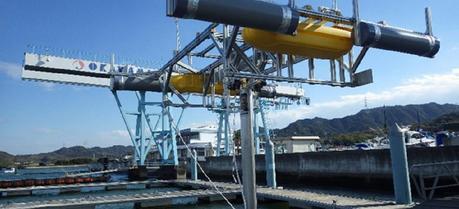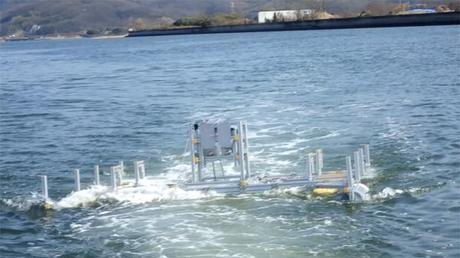 A pendulum-dynamo generator could be a better alternative to tidal turbines. (Credit: Okayama University)
A pendulum-dynamo generator could be a better alternative to tidal turbines. (Credit: Okayama University)Scientist at the Okayama University in Japan has developed a new pendulum-dynamo device that generates electricity from tidal currents.
“I want to exploit the mechanical motion of a pendulum to generate electricity from tidal currents,” says Shinji Hiejima, an associate professor at the Graduate School of Environmental and Life Science of Okayama University. Hiejima was born in Iwakuni City, Yamaguchi Prefecture, famous for its Kintaikyo Bridge.
SEE ALSO: Pelamis P2 Wave Energy Converters Reach 10,000 Hours Milestone

Hydrokinetic Vortex Energy Utilization System or Hydro-VENUS. (Credit: Okayama University)
“My fascination with the structure of bridges triggered my research on the interaction of strong winds with massive bridges such as the Seto Bridge that connects Okayama with Kagawa in Shikoku,” says Hiejima. “In my early research I analyzed why large bridges oscillate when hit by strong winds such as typhoons. Now, I am focusing on harnessing tidal energy as a stable source of electricity. I am looking for partners to develop my ideas on the Hydrokinetic Vortex Energy Utilization System or Hydro-VENUS—a large underwater pendulum based system.”
Hiejima points out that propeller type turbine systems being tested in Europe has three major drawbacks: High strength required for the materials used for making the rotor blades leads to increases in cost; waste in the ocean clogs up and damages rotors; and, fisherman consider the sharp edges of rotor blades to be harmful to marine life.
To resolve these limitations of propeller based tidal energy conversion, Hiejima began by analyzing the potential of power generated by flow induced vibrations of cylinders placed horizontally in water. This approach overcomes aforementioned shortcomings of propeller but the vortex induced vibrations—the cylinder moves translationally as waves moves across them—in these systems typically only yields a power efficiency of approximately 37% of so-called VIVACE converter obtained in the experiments of a group in the USA.

Hydro-VENUS system during offshore towing experiments. (Credit: Okayama University)
“The translational motion of cylinders (such as used in VIVACE) limits the efficiency of tidal flow induced vibrations of cylinders,” says Hiejima. “My concept for the Hydro-VENUS does not vibrate translationally but rotationally, and initial tests yielded a power efficiency of 76%.” Early tests were carried out using 1.5 m cylinders. Hiejima is now developing 20 m cylinders from a wide range of materials with the goal of producing highly efficient structures.
“I have patented and demonstrated the potential for my version of a pendulum-dynamo,” says Hiejima. “I am looking for industrial partners to commercialize it.”

